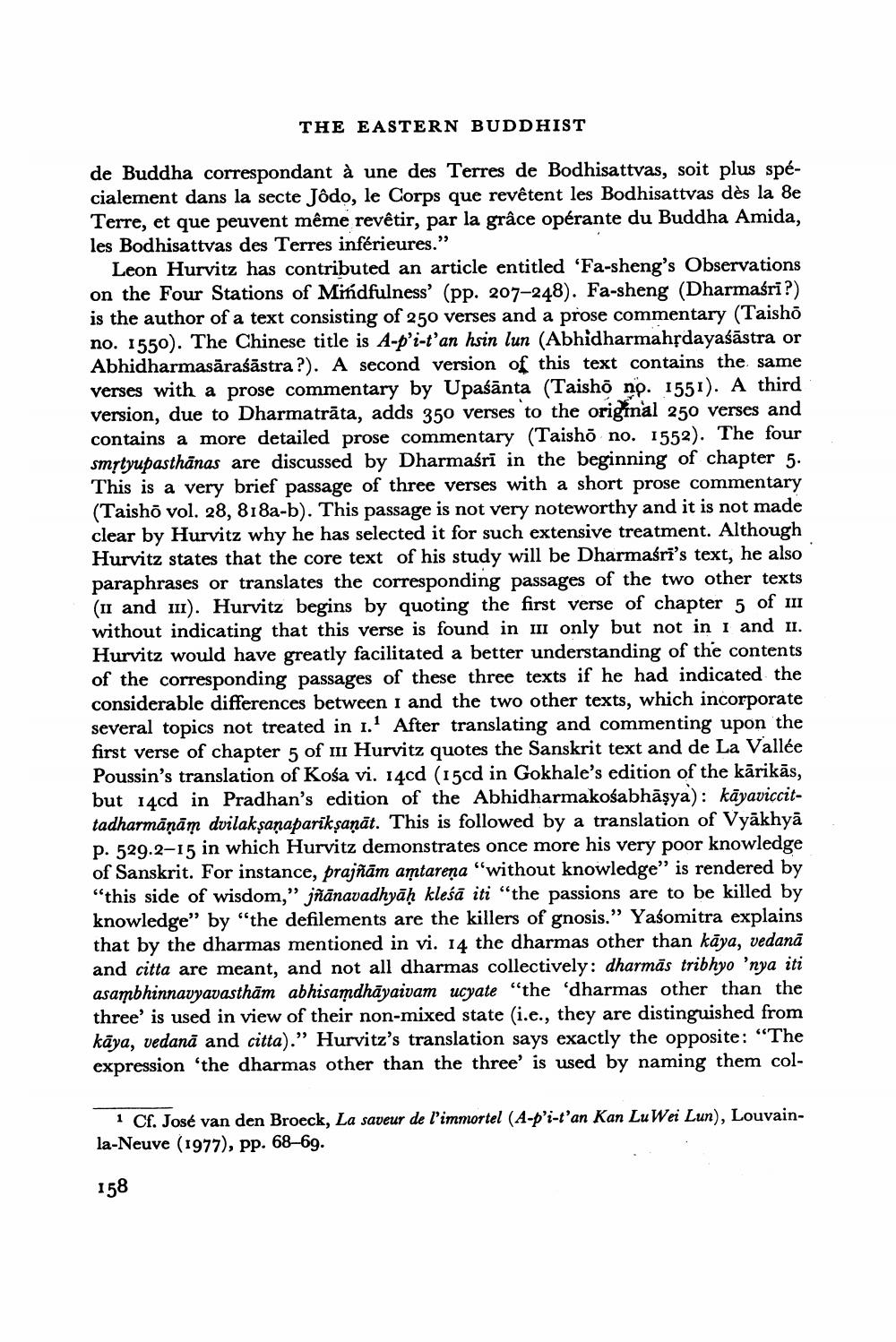________________
THE EASTERN BUDDHIST
de Buddha correspondant à une des Terres de Bodhisattvas, soit plus spécialement dans la secte Jôdo, le Corps que revêtent les Bodhisattvas dès la 8e Terre, et que peuvent même revêtir, par la grâce opérante du Buddha Amida, les Bodhisattvas des Terres inférieures."
Leon Hurvitz has contributed an article entitled 'Fa-sheng's Observations on the Four Stations of Mindfulness' (pp. 207-248). Fa-sheng (Dharmaśri?) is the author of a text consisting of 250 verses and a prose commentary (Taishō no. 1550). The Chinese title is A-p'i-t'an hsin lun (Abhidharmahṛdayaśāstra or Abhidharmasaraśāstra?). A second version of this text contains the same verses with a prose commentary by Upaśānta (Taisho no. 1551). A third version, due to Dharmatrāta, adds 350 verses to the original 250 verses and contains a more detailed prose commentary (Taishō no. 1552). The four smrtyupasthanas are discussed by Dharmaśrī in the beginning of chapter 5. This is a very brief passage of three verses with a short prose commentary (Taisho vol. 28, 818a-b). This passage is not very noteworthy and it is not made clear by Hurvitz why he has selected it for such extensive treatment. Although Hurvitz states that the core text of his study will be Dharmasri's text, he also paraphrases or translates the corresponding passages of the two other texts (I and II). Hurvitz begins by quoting the first verse of chapter 5 of III without indicating that this verse is found in III only but not in I and II. Hurvitz would have greatly facilitated a better understanding of the contents of the corresponding passages of these three texts if he had indicated the considerable differences between 1 and the two other texts, which incorporate several topics not treated in 1.1 After translating and commenting upon the first verse of chapter 5 of III Hurvitz quotes the Sanskrit text and de La Vallée Poussin's translation of Kosa vi. 14cd (15cd in Gokhale's edition of the kārikās, but 14cd in Pradhan's edition of the Abhidharmakośabhāṣya): kāyaviccittadharmāṇām dvilakṣaṇaparikṣaṇāt. This is followed by a translation of Vyakhyā p. 529.2-15 in which Hurvitz demonstrates once more his very poor knowledge of Sanskrit. For instance, prajñām amtarena "without knowledge" is rendered by "this side of wisdom," jñānavadhyāḥ kleśā iti "the passions are to be killed by knowledge" by "the defilements are the killers of gnosis." Yaśomitra explains that by the dharmas mentioned in vi. 14 the dharmas other than kaya, vedanā and citta are meant, and not all dharmas collectively: dharmās tribhyo 'nya iti asambhinnavyavastham abhisamdhayaivam ucyate "the 'dharmas other than the three' is used in view of their non-mixed state (i.e., they are distinguished from kaya, vedanā and citta)." Hurvitz's translation says exactly the opposite: "The expression 'the dharmas other than the three' is used by naming them col
1 Cf. José van den Broeck, La saveur de l'immortel (A-p'i-t'an Kan Lu Wei Lun), Louvainla-Neuve (1977), pp. 68-69.
158




